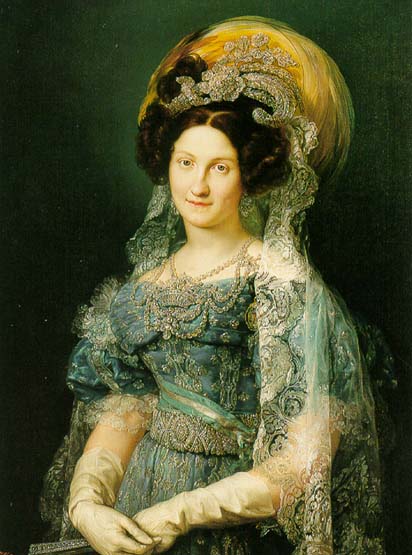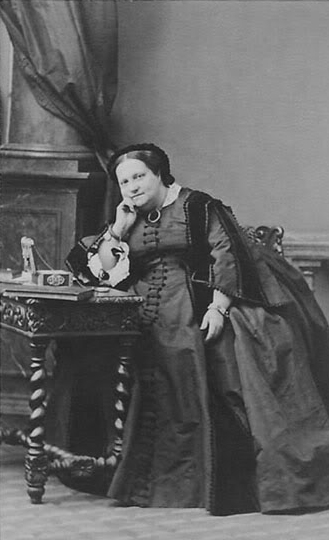<Back to Index>
- Inventor Samuel Finley Breese Morse, 1791
- Composer Sergei Sergeyevich Prokofiev, 1891
- Queen Consort of Spain Maria Christina of the Two Sicilies, 1806
PAGE SPONSOR


Maria Christina of the Two Sicilies (Italian: Maria Cristina Ferdinanda di Borbone, principessa delle Due Sicilie, Spanish: María Cristina de Borbón, princesa de las Dos Sicilias; 27 April 1806 – 22 August 1878) was Queen Consort of Spain (1829 to 1833) and Queen Regent of Spain (1833 to 1840).
Originally titled Her Royal Highness Princess Maria Christina of Naples and Sicily, on 18 December 1816 her title was changed to Princess Maria Christina of the Two Sicilies when her father changed the name of his kingdom. Her Spanish name was María Cristina de las Dos Sicilias.
Born in Palermo, Sicily, Italy on 27 April 1806, she was
the daughter of King Francis
I (In Italian,
Francesco I) of the Two Sicilies by his second wife, Maria
Isabella
of Spain. She also descended from the Austrian Habsburgs
as her grandmother was Queen Marie Caroline and her
grand aunt was Marie
Antoinette. Maria
Christina married King Ferdinand
VII
of Spain on 11
December 1829 in Madrid. Ferdinand was her uncle by birth and by
marriage. Like her mother Maria Isabella, Ferdinand was a child of King Charles
IV
of Spain (Carlos IV in Spanish) and
his wife, Maria Luisa
of Parma. With the death of King's third wife on 27 May 1829,
Ferdinand's desperation to father an heir for his crown resulted in his
fourth marriage just seven months later. The new
queen, Maria Christina, rapidly gave birth to two daughters, Isabella
(the future Queen
Isabella, 1830 – 1904) and the Infanta Doña
María Luísa Fernanda (1832
– 1897). When Ferdinand
died on 29 September 1833, Maria Christina became regent for their
daughter Isabella. Isabella's claim to the throne was disputed by her
uncle, the Infante
Don
Carlos María Isidro Benito, Count de Molina, who claimed
that his brother Ferdinand had unlawfully changed the succession law to
permit females to inherit the crown (Carlism).
Some
supporters of Don Carlos went so far as to claim that Ferdinand
had actually bequeathed the crown to his brother but that Maria
Christina had suppressed that fact. It was further alleged that the
Queen had signed her dead husband's name to a decree recognizing
Isabella as heir. Carlos'
attempt to seize power resulted in the Carlist
Wars. Despite considerable support for Carlos from the Roman
Catholic Church and conservative elements in Spain, Maria Christina
successfully retained the throne for her daughter. The Carlist Wars
grew from a dispute about the succession into a dispute over the future
of Spain. The supporters of Maria Christina and her daughter favored a
liberal constitution and progressive social policies. In contrast,
Carlos' supporters (called Carlists)
favored
a return to traditional society and an absolute monarchy.
Ultimately, the army's loyalty to Isabella II proved the decisive issue
in the war. On 28
December 1833, shortly after the death of Ferdinand VII, Maria
Christina had secretly married an ex-sergeant from the royal guard, Agustín
Fernández
Muñoz, Duke of Riansares (1808 – 1873).
Muñoz
was given the title Duke of Riansares. Maria Christina and Muñoz
had several children together while trying to keep their marriage a
secret. Eventually,
news
of Maria Christina's marriage to this low-ranking soldier became
public. That news made the Duchess of Riansares deeply unpopular. Her
position was undermined by news of her remarriage and concerns that she
was not actually supportive of her liberal ministers and their
policies. Eventually, the army, which was the backbone of Isabella II's
support, and the liberal leadership in the Cortes combined to demand that
Maria Christina stand aside from the regency. In 1840, the army
commander, General Baldomero
Espartero,
Count of Luchana, replaced her as regent. The new
government required the ex-regent to leave Spain. After an unsuccessful
attempt to return to power, Maria Christina retired permanently to
exile in France after 1844. France remained her primary residence for
the remainder of her life. A
revolution forced daughter Isabella II from her throne on 30 September
1868 and she joined her mother in exile in France. Isabella II renounced the throne in favor of her son, Alfonso
XII,
on 25 June 1870. Supporters of Alfonso XII made it clear that
neither his mother nor grandmother could play an active role in the
effort to restore the monarchy. When Alfonso XII regained the Spanish
crown on 29 December 1874, Maria Christina and Isabella II were
permitted to return to Spain as visitors but denied permission to live
there permanently. Neither was allowed to exercise influence in the
Spanish government. The
marriage to Muñoz and the events of Maria Christina's turbulent
regency drove a permanent wedge between her and her Spanish royal
offspring. Neither Isabella II nor Alphonso XII had much interest in a
relationship with the former Queen Regent. Maria Christina
died in Le
Havre, France on 22 August 1878. As the
widow of Ferdinand
VII and the mother
of Isabella
II, Maria Christina was buried in the royal crypt of El
Escorial
monastery.